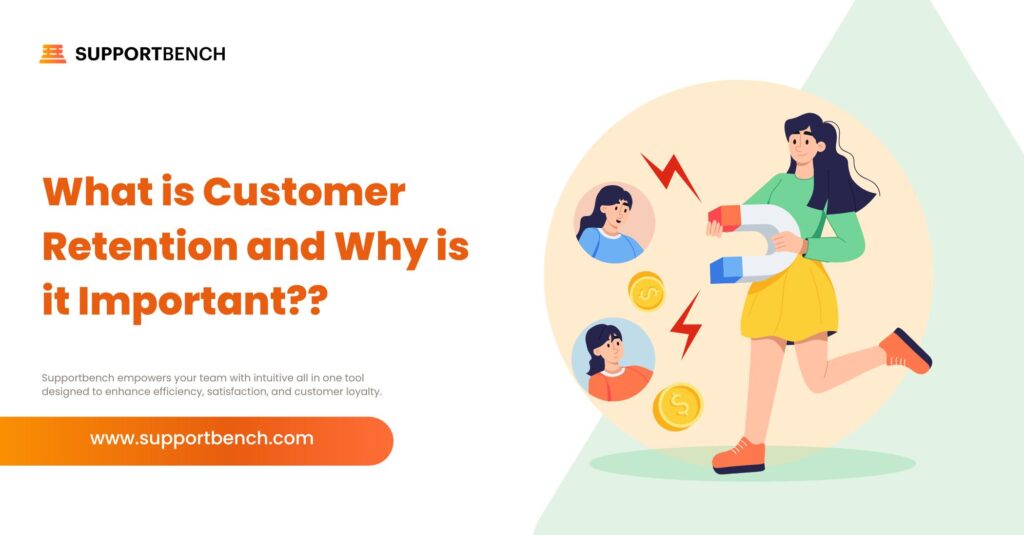Holding onto the customers you have already won is more critical now than ever before. But, customer retention goes far beyond making a sale; it’s building long-term relationships where first-time buyers become brand ambassadors.
Although most companies want to focus on acquiring new customers, companies that focus on retaining their customers receive substantial competitive advantages by saving on costs, driving consistent revenue, and building a loyal community around their brand.
Of course, none of that happens automatically. It results from a combination of great service, unique experiences, and timely follow-ups. With the proper set of tools, this may also be automated. This is where Supportbench comes in, offering companies advanced solutions to manage customer success and keep customers returning for more.
What is Customer Retention?
Customer retention describes the process of building customer loyalty in order to make repeat purchases. It essentially measures the degree of brand loyalty your brand operates, which shows customers’ preference for one’s brand over other brands offering similar services.
Customer retention means your customers are dedicated to your brand’s offerings, and it can lend itself to your growth. Instead of continuously churning out new customers, repeat customers speak to their satisfaction with your brand.
It’s also a crucial step in the customer experience found near the end of the customer journey map, loosely following customer acquisition and bringing your brand to new customers.
For more established brands, nurturing customer retention and loyalty can be almost as important as attracting new customers.

Why is Customer Retention Important?
Customer retention measures how well the company retains old customers and attracts new ones. It improves Return on Investment (ROI), builds brand loyalty, and helps attain new customers. Keeping existing customers is less costly and easier than finding new ones.
Returning customers spend more money in sales, buy products more often, and refer others. Even a 5% increase in customer retention increases revenues by 25-95%. The facts show that keeping customers is very beneficial for companies.
There can be several reasons why customer retention is so crucial for growth and success. These include:
- Affordability: It costs six to seven times more to acquire a new customer than to keep an old one.
- ROI: A 5% increase in customer retention can raise revenues by 25-95%.
- Loyalty: Returning customers purchase more frequently and spend more money. They understand the value of the product or service and keep coming back.
- Word of mouth: Happy customers will refer friends and family to the company, providing new customers at no additional cost.
Methods to Improve Customer Retention

Customer retention starts with making customers happy. Customers are more loyal to companies that provide a good experience. To keep customers, you should use strategies that build loyalty and increase customer lifetime value (LTV).
Focus on Current Users More Than New Users
It’s easier to keep existing customers than to attract new ones because you already have a relationship with them. Analyze the behaviors and preferences of these groups to understand what keeps them coming back.
For example, if existing users prefer an orange purchase button on your site, ensure all buttons are orange to encourage more sales.
Listen to Customers and Use Their Feedback
Combine insights from your customer service team with direct feedback from customers through surveys, social media comments, and online discussions. Pay attention to how customers interact with your company.
For instance, improve your phone service if they prefer phone support over online chat. Understanding customer needs helps you make better products and services.
Provide Personalized and Efficient Support
Your support team should access relevant customer information to create personalized interactions. This shows you care about building relationships, which helps keep customers.
Use technology like chatbots to connect customers with the right support staff and make personalized recommendations. Streamline your support processes and offer multiple ways for customers to get help, such as mobile, website, phone, or in-person options.
Reward Loyal Customers
Create personalized loyalty programs that reward repeat purchases to make loyal customers feel valued. Offer special deals and discounts to encourage them to keep buying from you. The more you know about your customers’ purchases, the better you can tailor your rewards.
Support Causes Your Customers Care About
This helps build an emotional connection. Seventy percent of consumers want brands to take a stand on social issues, and 77% are more likely to buy from companies that aim to improve the world.
How Do You Measure Customer Retention?
The major metrics used for customer retention are customer retention rate and customer retention cost. Other important metrics include the purchase quantity, frequency, and lifetime value.

Customer Retention Rate (CRR)
Customer retention rate, or CRR, describes how well you keep customers over a period. To find your CRR, compare the number of customers you have at the beginning of the period to those you have at the end, including any new customers. You can do this through the formula:
- Customer Retention Rate = ((Total Customers – New Customers) / Initial Customers) x 100
Cost of Customer Retention
Customer retention cost is the overall cost of keeping a customer. This includes costs for marketing, sales, and customer service. The following formula can derive the average cost per customer in customer retention:
- Average Customer Retention Cost per Customer = Total Cost of Customer Retention / Number of Active Customers
How Supportbench Can Improve Your Customer Retention?
Supportbench offers an extended platform to manage customer interactions and further improve the quality of service. Among the significant features are ticket management, workflow automation, and customizable customer portals that help facilitate the process of customer support and allow personalized and efficient service from your team.
By using tools for SLA management, escalation handling, and multi-channel communication, businesses can boost customer retention by providing the exceptional service needed to keep customers coming back.
Start transforming your customer relationships today with Supportbench. Explore how our platform can help you streamline support, increase loyalty, and drive long-term success. Get started with Supportbench now!
Conclusion
Customer retention is key to long-term business success because it saves resources and brings in more value compared to creating new customers. By focusing on keeping your customers happy through personalized service, timely follow-ups, and meaningful interactions, you will keep a customer base that will continue to drive revenue and growth for your business.
Supportbench can be a critical tool in managing customer relationships efficiently. It has the potential to automate processes, provide good service, and encourage customers to return.
FAQs
1- What are the five key factors of customer retention?
To improve customer retention, target the right customers based on data, including industry, CLV, NPS score, relationship strength, and renewal date. Keep them engaged across all channels, understand customer behavior, and measure success to prove it works. Utilize your CS team’s knowledge through weekly meetings, which can improve retention by nearly 40%.
2- What are the 3 R’s of customer retention?
The 3 R’s of customer loyalty are three important strategies businesses use to keep customers loyal: reward, relevance, and recognition. Marketing executive Paulo Claussen created this term to help brands develop effective loyalty programs.
3- What is one key to customer retention?
Training and regular communication are essential for keeping customers because they help users see the value of your product faster. Updates should share information about changes, new features, and helpful tips to ensure users can use your product effectively.












